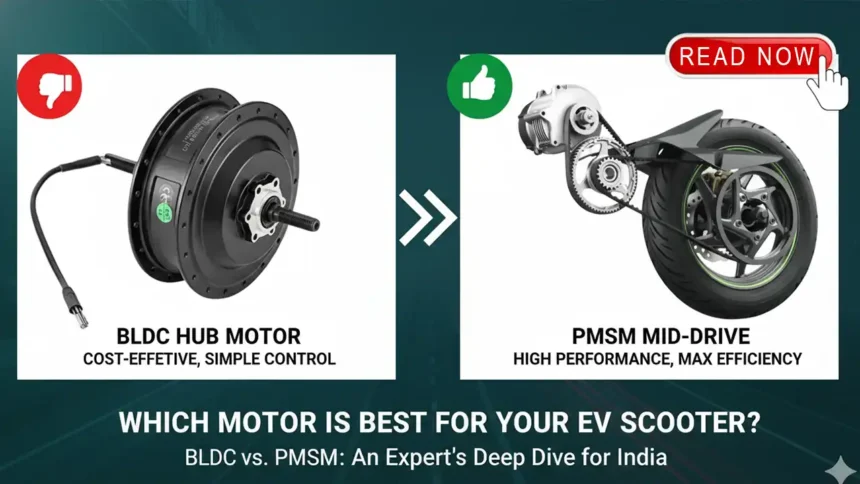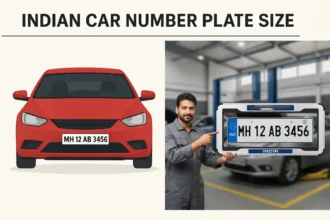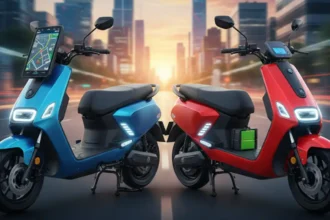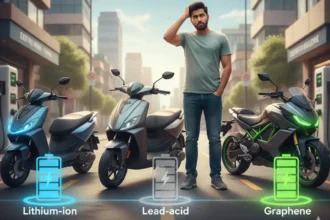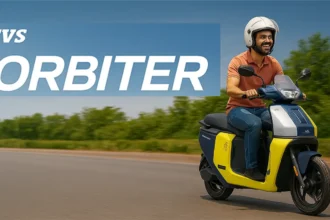The Electric Motor Mystery: Which Motor is Best for EV Scooter?
The transition from petrol to electric scooters in India is driven by the quest for cleaner, cheaper, and smarter urban mobility. However, the quality and type of the EV motor used can vary widely across models, especially between Premium EV Scooters and more cost-effective local EV scooters. The two dominant types of permanent magnet motors powering modern e-scooters are the Brushless DC (BLDC) motor and the Permanent Magnet Synchronous Motor (PMSM). Understanding the fundamental differences in their design, performance, and cost is crucial for making an informed purchasing decision.
Key Motor Specifications at a Glance
| Feature | BLDC Motor | PMSM Motor |
| Back EMF Waveform | Trapezoidal | Sinusoidal |
| Stator Winding | Concentrated (Simple) | Distributed (Complex) |
| Commutation/Control | Simple (Trapezoidal/Six-step) | Complex (FOC – Field-Oriented Control) |
| Torque Ripple | Higher (Can cause slight jerks/noise) | Lower (Smoother, quieter operation) |
| Efficiency | Very Good (Generally High) | Excellent (Higher across a wider speed range) |
| Cost | More Cost-Effective | More Expensive |
| Ideal Use | Economical, low to mid-power, low-speed city scooters | Premium, high-performance, high-speed scooters, electric cars |
Type of Motor for EV Scooter: Deep Dive into BLDC and PMSM
Both BLDC and PMSM motors are types of Brushless Motors, meaning they use electronic commutation instead of physical brushes, resulting in high reliability and low maintenance—a massive advantage for all modern electric two-wheelers. The primary difference lies in the design of the stator winding and the resulting back Electromotive Force (EMF) waveform.
1. BLDC Motor Technology: The Workhorse of Indian EVs
BLDC motors are the most common type found in a majority of electric scooters in India, especially in the budget and mid-range segments.
Specifications and Details:
- Trapezoidal Back-EMF: The back EMF generated as the rotor spins is roughly trapezoidal (square-like) in shape. This is due to the concentrated windings in the stator, meaning the windings are bundled together on salient poles.
- Simple Control: BLDC motors use a relatively simple control technique called trapezoidal commutation or six-step commutation. This involves switching the current to the stator windings in a simple, step-like pattern based on rotor position, often sensed by Hall-effect sensors.
- Cost-Effective: The simpler winding design and control mechanism make BLDC motors significantly more cost-effective to manufacture and implement. This is a key reason why BLDC motor is used in electric vehicles like entry-level and mid-range electric scooters where cost is a major factor.
- Good Efficiency: BLDC motors offer excellent efficiency at constant, low-to-mid speeds, making them perfect for stop-and-go city commutes in India.
2. PMSM Motor Technology: The Premium Powerhouse
PMSM motors, sometimes referred to as BLAC (Brushless AC) motors, are typically found in premium EV scooters and high-performance electric motorcycles.
Specifications and Details:
- Sinusoidal Back-EMF: The back EMF is smoothly sinusoidal (wave-like), achieved through distributed windings in the stator. This means the copper windings are spread out evenly.
- Complex Control (FOC): PMSM motors require a much more sophisticated control system called Field-Oriented Control (FOC) or vector control. FOC ensures that the stator current is perfectly sinusoidal and in precise alignment with the rotor’s magnetic field, allowing for continuous and smooth control of torque.
- High Efficiency and Power Density: PMSMs offer excellent efficiency across a wider range of speeds and loads. They are known for high power density (more power for the same size) and better thermal management.
- Low Noise and Torque Ripple: The smooth sinusoidal current results in significantly reduced torque ripple (less jerking/vibration) and exceptionally quiet operation, contributing to a smoother and more refined ride quality—a major advantage of PMSM motor over BLDC motor.
- More Expensive: The complex winding, higher precision manufacturing, and advanced FOC controller make PMSM motors and their systems more expensive.
BLDC vs PMSM Motor Technology: Pros and Cons
Understanding the trade-offs between the two is key to knowing pmsm vs bldc which is better for a specific EV scooter application.
Pros and Cons of BLDC Motors
| Pros (Advantages) | Cons (Disadvantages) |
| Low Manufacturing Cost: Simple design keeps the scooter price competitive. | Higher Torque Ripple: Can lead to a slightly noisier and less smooth ride. |
| Simple Control: Easier and cheaper to control with basic electronic hardware. | Lower Peak Efficiency Range: High efficiency mostly at a limited speed band. |
| High Reliability: Proven technology with a long service life. | Limited High-Speed Performance: Less optimal for sustained high-speed riding. |
Pros and Cons of PMSM Motors
| Pros (Advantages) | Cons (Disadvantages) |
| Superior Efficiency: Maintains high efficiency across a broader speed range, optimizing battery range. | High System Cost: Expensive motor and the need for complex FOC controllers increase the price. |
| Low Noise and Smooth Operation: Excellent ride refinement due to very low torque ripple. | Complex Control: FOC implementation is challenging, requiring sophisticated software and tuning. |
| High Power and Torque Density: Better performance, acceleration, and hill-climbing ability. | Rare-Earth Magnet Dependence: Most use expensive Neodymium magnets, though alternatives are emerging. |
Premium EV Scooter Technology vs. Local EV Scooter Technology
The choice of motor is often the biggest differentiator between a premium EV scooter and a local EV scooter in India.
Premium EV Scooters: Focus on Performance and Refinement
Leading manufacturers in the premium segment (like Ola Electric, Ather Energy, and TVS iQube on their high-end variants) are increasingly adopting PMSM motor technology or highly optimized, high-power BLDC systems that mimic PMSM characteristics.
- Technology: These scooters use advanced Permanent Magnet motors (often PMSM or high-spec BLDC) coupled with sophisticated FOC controllers.
- Result: This pairing delivers quick acceleration, higher top speeds, and a very smooth, silent riding experience. The advanced control also allows for highly efficient regenerative braking, maximizing the EV range.
- Example: Scooters like the Ather 450X (known for a well-tuned motor) or the high-power Ola S1 Pro focus on performance metrics that only advanced motor technology can provide.
Local/Budget EV Scooters: Focus on Cost-Effectiveness
Most mass-market and budget electric scooters (especially those with lower top speeds) rely on standard BLDC hub motors.
- Technology: They use simpler BLDC hub motors (installed directly in the wheel hub) with basic trapezoidal control.
- Result: This keeps the cost down and simplifies the transmission (no gears needed). While they are perfect for low-speed, short-distance commutes, they may exhibit more motor noise, slightly lower acceleration, and a reduction in efficiency at very high or very low speeds compared to PMSM-equipped rivals.
- Common Use Case: This is the ideal setup for scooters used primarily for short, city-based commutes where affordability and simplicity are the top priorities.
EV Scooter Models with BLDC Motors (Indian Market)
BLDC motors are often favored in budget-friendly and lower to mid-speed commuter scooters due to their simplicity, reliability, and lower manufacturing cost. They are generally seen as reliable workhorses for daily commuting.
Some models expected to feature BLDC motors in the 2025 Indian market include:
- ZELIO: These brands use a hub-mounted BLDC motor.
- Hero Electric Models (e.g., Flash LX, Optima CX): Many of Hero Electric’s commuter and low-speed scooters utilize BLDC hub motors.
- Okinawa Models (e.g., Okinawa R30, PraisePro): Several budget-focused Okinawa scooters feature BLDC motors.
- Yulu Wynn: This low-speed scooter utilizes a BLDC hub motor.
EV Scooter Models with PMSM Motors (Indian Market)
PMSM motors (or variations like IPM – Internal Permanent Magnet motors) are generally preferred for high-performance and premium scooters. They offer higher efficiency, greater power density, and better torque output for quick acceleration and higher top speeds.
Models expected to utilize PMSM motors (or related advanced motors) in the 2025 Indian market include:
- Ather 450X/450S/Rizta: Ather is known for using PMSM motors in its models for their performance and efficiency.
- Honda Activa e: The electric version is listed with a PMSM motor.
- Vida V1 Pro/VX2: Hero MotoCorp’s premium EV sub-brand, Vida, uses a PMSM motor in its V1 series.
- OLA S1 Pro: While listed with a “Mid Drive IPM (Internal Permanent Magnet)” motor, this is a sophisticated type of synchronous permanent magnet motor, similar in principle to PMSM but optimized for mid-drive configurations.
Which Motor is Best for EV Scooter in India?
The “best” motor is subjective and depends entirely on the rider’s priority:
- For Performance and Refinement (The Best Overall Technology): The PMSM motor is superior. It offers maximum efficiency, minimum noise, and the best performance across the entire speed envelope. If your budget allows, and you want a scooter for high speeds, long distances, and a petrol-scooter-like refinement, PMSM or its high-end optimized equivalents are the way to go. This ensures maximum efficiency and a quieter, more comfortable ride.
- For Affordability and Reliability (The Best Value for Money): The standard BLDC motor is the better choice. For the average Indian commuter focused on low running costs, sufficient power for city traffic, and an affordable purchase price, a well-built BLDC motor in a reliable scooter is more than adequate. This technology is robust, dependable, and helps keep the scooter price accessible.
The trend for Electric Vehicle Technology in India suggests that as manufacturing scales up and FOC controllers become cheaper, more mid-range scooters will slowly migrate towards PMSM or optimized BLDC systems to meet the growing consumer demand for better performance and refinement.
Suggestions and Conclusion
As an EV Expert, my final suggestion is to prioritize the entire powertrain package—not just the motor name. A highly optimized, liquid-cooled, mid-drive BLDC system with advanced FOC control can outperform a basic PMSM hub motor.
Key Buying Tips for Indian Consumers:
- Check Peak Power (kW): A higher peak power and continuous power rating (e.g., 4.5 kW peak or more) generally indicates a more capable motor, regardless of type.
- Look for Mid-Drive Systems: Mid-drive motors are superior for performance, efficiency, and handling in a high-speed scooter.
- Test for Torque Ripple: Pay attention to how smoothly the scooter accelerates from a standstill. If it feels exceptionally silent and smooth, it likely has a motor with low torque ripple (like a PMSM or well-tuned BLDC).
The Electric Scooter Motor market in India is rapidly maturing. While BLDC motors remain the foundation of mass-market EV mobility due to their low cost and high reliability, the PMSM motor (or its advanced variations) represents the future for high-performance and premium electric scooters, offering a superior blend of efficiency, power, and riding comfort. Choose your motor based on your riding needs and budget—both technologies are reliable, but only one offers the absolute cutting edge in EV two-wheeler performance.
FAQs
Q1. What is the difference between BLDC and PMSM in EV?
A. The main difference is the Back-EMF waveform (Trapezoidal for BLDC, Sinusoidal for PMSM) and the control method (simple six-step for BLDC, complex Field-Oriented Control (FOC) for PMSM). PMSM generally offers smoother, more efficient performance across all speeds.
Q2. What are the advantages of PMSM motor over BLDC motor?
A. PMSM motors have much lower torque ripple (meaning a smoother, quieter ride), higher efficiency over a wider speed range, and higher power density, making them ideal for high-performance EVs.
Q3. Why is BLDC motor used in electric vehicle scooters?
A. BLDC motors are popular because they are cost-effective to manufacture, are highly reliable, require a simpler and cheaper controller, and provide sufficient performance for standard city commuting, keeping the overall scooter price low.
Q4. Is a Hub Motor better than a Mid-Drive Motor?
A. For high-performance and better handling, a Mid-Drive motor (often paired with a PMSM or high-spec BLDC) is typically better. Hub motors are simpler, cheaper, and lower maintenance, making them suitable for low-speed and budget-friendly scooters.

